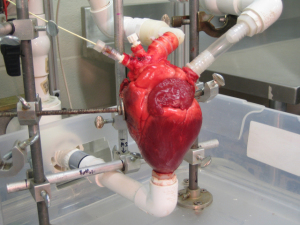Pig Heart Machine Aids Cardiovascular Researchers
by
Lynn Shapiro, Writer | May 18, 2009

Dynamic heart system
Photo: Andy Richards, North Carolina State University
A new machine developed at North Carolina State University makes an animal heart pump much like a live heart after it has been removed from the animal's body, allowing researchers to expedite the development of new tools and techniques for heart surgery.
The machine saves researchers time and money by allowing them to test and refine their technologies in a realistic surgical environment, without the cost and time associated with animal or clinical trials.
Currently, most medical device prototypes designed for use in heart surgery are tested on live pigs, which have heart valves that are anatomically similar to human heart valves. However, these tests are both expensive and time-consuming, and involve a lengthy permission process to ensure that the use of live animals is necessary.
So, researchers at NC State have developed a "dynamic heart system,, a machine that pumps fluid through a pig heart so that it functions in a very realistic way. "Researchers can obtain pig hearts from a pork processing facility and use the system to test their prototypes or practice new surgical procedures," says Andrew Richards, a Ph. D. student in mechanical engineering at NC State who designed the heart machine.
The computer-controlled machine, which operates using pressurized saline solution, also allows researchers to film the interior workings of the pumping heart, enabling them to ascertain exactly which surgical technologies and techniques perform best for repairing heart valves.
By using the machine, researchers can determine if concepts for new surgical tools are viable before evaluating them on live animals. They can also identify and address any functional problems with new technological tools. "There will still be a need for testing in live animal models," says Dr. Greg Buckner, who directed the project, "but this system creates an intermediate stage of testing that did not exist before. It allows researchers to do 'proof of concept' evaluations, and refine the designs, before operating on live animals." Buckner is an associate professor of mechanical and aerospace engineering at NC State.
Using the system could also save researchers a great deal of money. Once the machine is purchased and set up, the cost of running experiments is orders of magnitude less expensive than using live animals.
"It costs approximately $25 to run an experiment on the machine," says Richards, "whereas a similar experiment using a live animal costs approximately $2,500."
The Annals of Biomedical Engineering published the research, "A Dynamic Heart System to Facilitate the Development of Mitral Valve Repair Techniques," in late April.
Source: North Carolina State University
